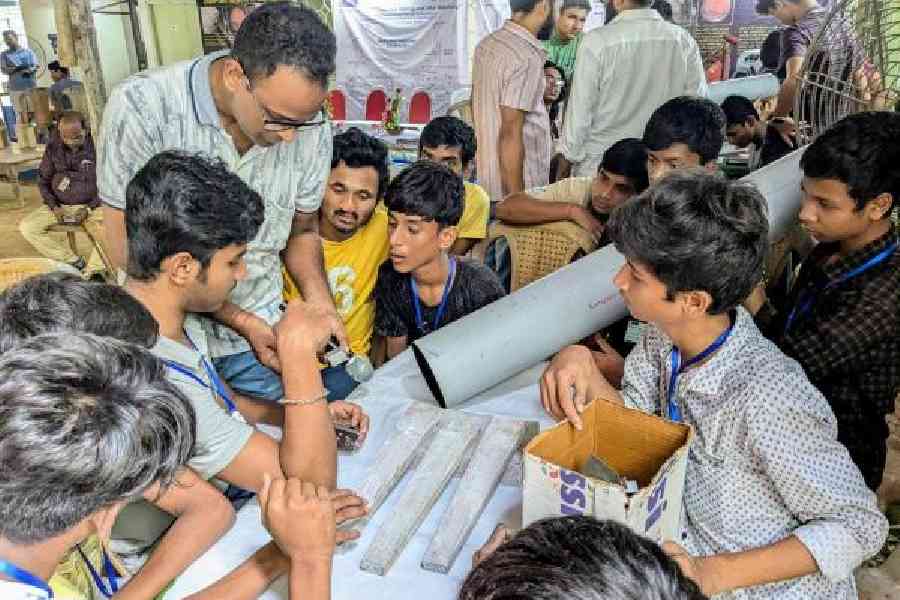Follow the Stars


What do craters on the moon look like upon close inspection? Is it really possible to see the rings of Saturn from Earth? Or the moons of Jupiter? These were some of the questions that would occur to 16-year-old Anushree Lohar when her physics teacher would describe the basics of a telescope in class. “He told us how this simple instrument reshaped humanity’s understanding of the universe,” says the Class XI student of science at Mandalkuli Netaji Vidyapith in Bankura.
Anushree had never seen a telescope but had read about Dutch spectacle-maker Hans Lippershey, who invented it. She also knew the story of Galileo Galilei improving on Lippershey’s design.
Ayushmann Kumar Singh, a Class IX student of Calcutta International School, loved his toy telescope. He read about the Hubble and James Webb telescopes and wondered what the sky looked like through a powerful telescope. “I have always wanted to learn the basics of building a telescope,” says he.
Both Anushree and Ayushmann’s wishes were fulfilled when they were selected by the Paschim Banga Samagra Shiksha Mission for a 12-day summer camp on telescope-making and skywatching at Sitapur, a village in West Midnapore.
The Paschim Banga Samagra Shiksha Mission is a government initiative to make learning more effective.
Experts at the observatory of the Indian Centre for Space Physics (ICSP), located in the quiet, picturesque village, taught them how to build a five-inch reflector telescope using easily available materials. Next, they used those telescopes to watch the clear night sky, free of the light pollution that is common in cities and towns. The ICSP is a premier research institute dedicated to astronomy, astrophysics and space science.
The children stayed in hostels, enjoyed their meals together, and heard stories about astronomers and their discoveries. “There were altogether eight schools from Bankura district. Each had sent 12 students and one teacher,” says Ratnadip Das, a Class IX student of Barjora High School in Bankura.“During the day, we built telescopes and at night we watched the stars,” he adds.
There were over 400 students spanning 32 schools from four districts of South Bengal at the camp. A team from each school was trained by ICSP scientists to put together a simple reflecting telescope — similar to the one invented by scientist Isaac Newton in 1668 — using PVC drain pipes, mirrors, nuts, bolts and clips supplied by the institute.
Tamal Basak, assistant professor at ICSP, says, “I was impressed by how enthusiastic the children were and how hard they worked, notwithstanding the intense heat.” Having constructed and tested the telescopes, they carried them to their respective schools. “We will share the experience with our friends who could not make it to the camp,” says Anushree.
In the evenings, ICSP astronomers conducted skywatching sessions using two powerful telescopes — Vashista and Arundhati — installed on the roof of the institute.
Anushka saw the moon’s dark craters, which she described as “bowl-shaped depressions”. She also saw the canyons of Mars and Spica, the “hot blue star in the constellation Virgo”.
Says Ayushmann, “The scientists taught us to fix solar filters in our telescopes and see sunspots during the day.”
The state government’s principal secretary of higher education Binod Kumar visited the camp. G.C. Anupama, former dean of the Indian Institute of Astronomy in Bangalore, says, “Skywatching, or stargazing, sparks curiosity among the young. Combined with workshops in telescope making, it inspires students to explore science through hands-on learning and direct observation of celestial phenomena.” According to her, such camps foster a deeper appreciation of science and technology, encouraging further study and potential careers in STEM fields.
Astronomer and director of ICSP Sandip Kumar Chakrabarti tells The Telegraph that his own interest in the subject arose from skygazing during his childhood in a village in Malda. He is concerned the exponential rise of light pollution in urban and semi-urban areas has impacted that kind of experience. He suggests more students visit the observatory on weekends to watch the night sky.
Chakrabarti says, “Skywatching sparks numerous unanswered questions in developing minds. These often help them become astronomers in future.”